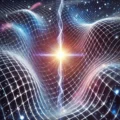Exploring the Concept of the Energy Continuum: Energy Self-Organization at the Quantum Scale
Introduction
The concept of the Energy Continuum (EC), as proposed within the framework of Quantum Admittance (QA), represents a profound shift from traditional views on energy distribution and organization at the quantum scale. This paper explores the intricacies of the Energy Continuum, examining its role as a dynamic network of energy quanta that influences the fabric of reality. By elucidating the principles governing the EC, we aim to uncover its implications for fundamental physics and the structure of the universe.
The Self-Generating Energy Continuum
The QA Paradigm introduces a novel perspective on the self-generating EC, suggesting that it is not merely a passive conduit for energy but an active participant in the creation and dissolution of space within it. This EC constitutes a dynamic network of energy that forms the foundation of reality, continually in flux and playing a crucial role in the emergence of matter, space, time, and gravity.
The structural components of the EC consist of initial energy quanta within a given volume, which diminish through an attenuation process necessary to construct each member along a polarized plane. Furthermore, the QA Paradigm posits that this self-generating EC represents vacuum impedance—a fundamental property of space. Vacuum impedance reflects the resistance of free space against the flow of electric current and represents the energy required to generate an electric field within a vacuum [1].
In terms of distribution, energy follows a wave pattern characterized by specific polarity and field shape determined by initial charge acceleration. This distribution, in open space, resembles that of a dipole antenna, exhibiting directional rather than isotropic field patterns [2]. Analogous to electromagnetic waves in radio frequencies, the EC’s charges experience displacement due to energy input, shaping the antenna accordingly.
Within the QA framework, mathematical formulations reveal complex structures, such as intertwined spinors, which undergo investigation as charges transition into various manifestations [3].
Theoretical Foundation:
At the core of QA lies the concept of the Energy Continuum—a foundational framework built upon the properties of electromagnetic permittivity (ε₀) and permeability (μ₀). The EC serves as the underlying structure upon which quantum energy dynamics unfold [4]. Unlike traditional views of space as a passive backdrop, the EC emerges as a self-organizing system, dynamically arranging energy quanta in ways that transcend conventional understandings of space.
The EC manifests as a dynamic network of energy quanta with self-organizing properties that influence energy distribution and propagation at the quantum level. Through the interplay of electric and magnetic fields, coupled with force interactions, the EC orchestrates the complex behavior of energy within the quantum realm. This self-organization results in a landscape of charges and fields that profoundly shapes the behavior of matter and energy [5].
Buried within the depths of QA mathematics lies a cryptic convolution akin to intertwined spinors within the EC, undergoing investigation as charges transition into alternative manifestations.
While traditional views of space see it as a passive backdrop, the Energy Continuum emerges as a self-generating system, dynamically organizing energy quanta in a manner that transcends the native properties of space.
Implications and Future Directions:
Exploring the Energy Continuum concept opens new avenues for understanding fundamental principles of energy self-organization in the universe. By elucidating how energy quanta interact within the EC, we deepen our comprehension of fundamental physics and may uncover novel phenomena. Future research directions could involve experimental validation of theoretical predictions and the development of computational models to simulate the behavior of the EC under various conditions [6].
The implications of this shift are substantial. By redefining gravity as a consequence of energy rather than mass, the QA framework challenges traditional theories such as the Big Bang and offers a new perspective on the origins and structure of space. This paradigm shift could reshape our cosmological narrative, leading to novel interpretations of cosmic phenomena and inviting exploration into new areas of theoretical physics [7].
Conclusion:
In conclusion, exploring the Energy Continuum represents a significant advancement in our understanding of energy distribution and organization at the quantum scale. By unraveling the complexities of the EC, we gain valuable insights into the principles governing the dynamics of the universe. As research continues, the Energy Continuum stands as a testament to the remarkable complexity and self-organizing nature of the cosmos.
References
[1] Jackson, J. D. (1998). Classical Electrodynamics (3rd ed.). Wiley. This reference provides a comprehensive overview of electromagnetic theory, including vacuum impedance.
[2] Feynman, R. P., Leighton, R. B., & Sands, M. (2011). The Feynman Lectures on Physics (Vol. 1). Basic Books. This text covers fundamental concepts in quantum mechanics and field theory.
[3] Zee, A. (2003). Quantum Field Theory in a Nutshell. Princeton University Press. This book explores advanced topics in quantum field theory, including mathematical structures related to spinors.
[4] Duffy, L. D. (2006). Electromagnetic Theory and Computation: A Topological Approach. CRC Press. This book discusses the roles of permittivity and permeability in electromagnetic theory
[5] Peskin, M. E., & Schroeder, D. V. (1995). An Introduction to Quantum Field Theory. Addison-Wesley. This reference provides foundational knowledge on quantum field theory and energy dynamics.
[6] Bender, C. M., & Orszag, S. A. (1999). Advanced Mathematical Methods for Scientists and Engineers: Asymptotic Methods and Perturbation Theory. Springer. This book details mathematical methods relevant to theoretical research in quantum mechanics.
[7] Guth, A. H. (1997). The Inflationary Universe: The Quest for a New Theory of Cosmic Origins. Random House. This work provides insights into cosmological theories and their implications for the structure of the universe.
